
Wine Culture and Information since 2002 - Volume 22
 Wine Culture and Information since 2002 - Volume 22 |
|
Comparing Montepulciano d'AbruzzoThe great red berried grape emblem of viticulture and enology of Abruzzo is since many years considered among the best expressions of Italian enology and great red wines |
|
Montepulciano certainly is one of the most famous and important red berried grapes of Italy. Mainly common in the region of Central Italy, Montepulciano is mainly identified with Abruzzo, the region in which it is also the most common and cultivated red variety. It is right in this region which is made one of the most renowned wines produced with this grape - Montepulciano d'Abruzzo - which in the last recent years, also thanks to the efforts and the good results achieved by producers, was successful in becoming among the most important wines of Italy, known everywhere in the world. Nevertheless, up to some tens of years ago, Montepulciano was considered, and not only in Abruzzo, a grape capable of making “ordinary” wines lacking of interesting qualities according to an organoleptic and enological point of view. As it happened for other grapes, the tenacity of producers, convinced with the grapes of their land was possible to make great wines, as well as the use of quality wine making techniques, also Montepulciano made a miracle and in few years it reached the top of Olympus. Montepulciano is also found in vineyards of Marches - with which it is produced, among the many, Rosso Conero and Rosso Piceno - Molise, Apulia, Umbria, Latium and, marginally, Apulia, Sardinia and Calabria. Famous for its excellent coloring qualities and for the quantity of extracts, Montepulciano has been used for years as a bulk grape, destined to give color and body to other wines, also thanks to its good production qualities. For this reason and for many years, Montepulciano has been cultivated with low quality principles, as its usage was mainly destined to the mixing with other grapes, once considered more noble. Indeed, when quality viticultural concepts are adopted, Montepulciano is capable of giving great wines, rich, thick and robust, rich in aromas that with time can give complexity to the nose of any careful wine taster. Thanks to the quantity of polyphenols and alcohol, quality wines produced with Montepulciano can in fact age in the bottle for many years, even more than 10 years in the best cases.
|
|
Montepulciano is a grape which tends to ripe later than other varieties, therefore its cultivation can be easily adapted to the areas with a mild climate also at the end of summertime and at the beginning of autumn. This characteristic in fact determines its geographic spreading, typically central and southern Italy. Among the many expressions of Montepulciano, the most famous wine certainly is the one produced in Abruzzo, whose wines will be the protagonists of our comparative tasting. Montepulciano d'Abruzzo, according to the production disciplinary, can be released for consumption after March 1st following harvesting, or after at least two years of aging for the “reserve” style. Montepulciano d'Abruzzo is generally aged in cask, however the aging in barrique is also frequent. Thanks to the quantity of sugar contained in this grape, Montepulciano d'Abruzzo is a wine with a pretty high alcohol by volume, sometimes higher than 14%.
Our comparative tasting will examine three Montepulciano d'Abruzzo wines in order to study the organoleptic qualities of this grape and the influence of the aging in wood according to the style and the choices done by each producer. The three wines of our comparative tasting will also allow the study of the huge wine making potentials of Montepulciano and its robust body. The first wine of our comparative tasting is Marramiero's Montepulciano d'Abruzzo Inferi, produced with mixed techniques, of which 24 months in steel tanks and 18 months in barrique. The second wine is Illuminati's Montepulciano d'Abruzzo Zanna, completely aged for 26 months in cask. The last wine of our comparative tasting is Masciarelli's Montepulciano d'Abruzzo Villa Gemma, aged for 36 months, of which 24 in barrique. The three wines will be served at the temperature of 18° C (65° F) and we will use - as usual - three ISO tasting glasses.
|
||||||||
|
Despite in past times Montepulciano was not considered that much for the production of mono varietal wines, however it has always been blended with all those grapes that - despite of their fame - were not capable of making wines rich in color. Montepulciano in fact has a good quantity of coloring substances, therefore in its wines transparency will be pretty low and the color will show very intense and deep hues. During its youth, wines produced with Montepulciano will clearly show this quality, with intense and deep ruby red color and evident nuances of purple red. Whereas purple red nuances will tend to disappear within two or three years - according to the quality of grapes and of wine making techniques - Montepulciano will show evident ruby red hues which will change into garnet red after some years of aging in bottle, whereas the nuance will change into garnet red color just after some years of aging. The first wine of which we will examine appearance is Marramiero's Montepulciano d'Abruzzo Inferi. By keeping the glass tilted over a white surface - a cloth or a sheet of paper will do - we will begin the evaluation of the intensity of color by observing the liquid mass at the base of the glass. This first wine will let us understand the appearance qualities of Montepulciano: pretty low transparency and a very intense ruby red color. By observing nuances - at the edge of the liquid mass towards the opening of the glass - we will notice the same color. Also the evaluation of the second wine - Illuminati's Montepulciano d'Abruzzo Zanna - confirms the appearance qualities of Montepulciano: low transparency, deep ruby red color and ruby red nuances. The transparency of the third wine, Masciarelli's Montepulciano d'Abruzzo Villa Gemma, is even lower than the previous two wines, with a very deep ruby red color and evident ruby red nuances.
|
|
The olfactory profile of Montepulciano is mainly characterized by the world of red and black berried fruits, as well as flowers, in particular in young wines. Thanks to its qualities, Montepulciano is generally aged in cask - frequently the barrique as well - however in some cases it is preferred to age it in inert containers, such as steel and cement. The choice of the container used for aging, of course, largely influences on Montepulciano's olfactory qualities, therefore contributing to the development of tertiary aromas. The aging of Montepulciano d'Abruzzo is generally made on cask and barrique, therefore in this wine we will frequently find tertiary aromas derived from wood. Black cherry and plum are the most typical and frequent aromas of Montepulciano d'Abruzzo, whereas the main representative of the world of flowers is violet. Among other fruit aromas which can be found are mentioned blueberry, blackberry and raspberry, whereas, as for flowery aromas, it is sometimes possible to find cyclamen. The first wine of which we will examine aromas in our comparative tasting is Marramiero's Montepulciano d'Abruzzo Inferi. By holding the glass in vertical position and without swirling, we will proceed with the first smell in order to evaluate opening aromas. From the glass will emerge aromas of black cherry and plum - the typical opening of Montepulciano d'Abruzzo - to which will follow the aroma of blackberry. Let's now swirl the glass in order to favor the volatilization of the other aromatic components and then we will proceed with a second smell. The aromatic profile of the wine will be completed by perceptions of blueberry and violet, followed by an interesting sequence of tertiary aromas of vanilla, cocoa, tobacco, licorice, cinnamon, mace and a pleasing hint of black pepper. Despite this wine is aged for 24 months in steel tanks, the following 18 months of aging in barrique have contributed - with balance and harmony - to the development of tertiary aromatic qualities. Let's now proceed with the evaluation of the second wine of our comparative tasting: Illuminati's Montepulciano d'Abruzzo Zanna. By holding the glass in vertical position, we will proceed with the evaluation of opening aromas which will be characterized by aromas of black cherry, plum and violet, also in this case very typical of Montepulciano. After having swirled the glass, we will proceed with a second smell in order to complete the olfactory profile of the wine. From the glass will be perceived aromas of blueberry and blackberry to which will follow tertiary aromas of vanilla, cinnamon, cocoa, tobacco, licorice as well as a pleasing hint of black pepper, also in this case fruit of the aging in cask. The opening of the third wine - Masciarelli's Montepulciano d'Abruzzo Villa Gemma - is characterized by black cherry, plum, blackberry and violet to which will follow, after having swirled the glass, aromas of black currant and blueberry completed by aromas of vanilla, cinnamon, cocoa, pink pepper, tobacco, licorice, leather, mace and a pleasing balsamic hint of menthol, result of the aging in cask for 24 months.
|
||||
|
Wines produced with Montepulciano, or better to say, with Montepulciano grapes from quality vineyards, are always characterized by a pretty robust structure. In fact, it is not rare to find a Montepulciano d'Abruzzo with powerful and robust bodies, a characteristic which is also produced by the aging in cask or barrique. The concentration of Montepulciano d'Abruzzo - produced with quality criteria - will be one of the first characteristics to be perceived to the mouth, with a pretty evident astringency. Another gustatory characteristic of Montepulciano d'Abruzzo is represented by its alcohol by volume, generally being pretty high - it is not rare to find a wines with more than 14% - a characteristic which is also useful for reaching a good balance with structure and astringency. The persistence of Montepulciano d'Abruzzo is generally very good and it is not rare to find wines with pretty long taste-olfactory persistence. The first wine we will examine in the gustatory phase is Marramiero's Montepulciano d'Abruzzo Inferi. The attack of this Montepulciano confirms the typical qualities of this wine: an evident astringency well balanced by alcohol and roundness, as well as an excellent correspondence to the aromas perceived by the nose, in particular black cherry and plum. The attack of the second wine - Illuminati's Montepulciano d'Abruzzo Zanna - is characterized by a pretty evident astringency and body, however well balanced by alcohol. Despite the robust attack, it should also be noticed the good and pleasing roundness of this wine. Full body is also what we perceive in the last wine of our comparative tasting - Masciarelli's Montepulciano d'Abruzzo Villa Gemma - to which is also perceived an evident astringency well balanced both by roundness and alcohol, in this case being of 14.5%. It should be noticed how in all the three wines it is possible to perceive an excellent correspondence to the nose and a good roundness given by the aging in cask or barrique.
|
|
Montepulciano d'Abruzzo is a wine generally having a very good taste olfactory persistence, very long persistence in case of wines produced with quality criteria. The finish of Marramiero's Montepulciano d'Abruzzo Inferi is persistent, leaving in the mouth evident and clean flavors of black cherry, plum and blackberry, very agreeable. Also the finish of Illuminati's Montepulciano d'Abruzzo Zanna is persistent and very clean, leaving in the mouth the typical flavors of black cherry and plum to which also follows the flavor of blueberry. The finish of Masciarelli's Montepulciano d'Abruzzo Villa Gemma is very persistent and robust, leaving in the mouth long and clean flavors of black cherry and plum - once again, typical and identifying qualities of Montepulciano - to which follows a pleasing and clean flavor of blackberry. The history of Montepulciano d'Abruzzo, which certainly has endless and important pages still to be written, can be defined as a “happy end” tale. Once considered as an ordinary wine - this is how it was defined more than 20 years ago - today Montepulciano d'Abruzzo is one of those important wines distinguishing Italian enology in the world.
|
Wines of the Month |
|
|
|
Score legend Prices are to be considered as indicative. Prices may vary according to the country or the shop where wines are bought |

|
|
Valpolicella Classico Superiore Vigneto Sant'Urbano 2004 |
|
| Speri (Veneto, Italy) | |
| Grapes: Corvina (70%), Rondinella (20%), Molinara (5%) | |
| Price: € 16.00 | Score: |
| This wine shows a brilliant ruby red color and nuances of garnet red, moderate transparency. The nose reveals intense, clean, pleasing and refined aromas that start with hints of blackberry, black cherry and plum followed by aromas of raspberry, blueberry, violet, vanilla, chocolate, mace and cinnamon. The mouth has good correspondence to the nose, a tannic attack and however balanced by alcohol, good body, intense flavors, agreeable. The finish is persistent with flavors of blackberry, plum and black cherry. Valpolicella Classico Superiore Vigneto Sant'Urbano ages for 18 months in cask. | |
| Food Match: Roasted meat, Braised and stewed meat with mushrooms, Hard cheese | |
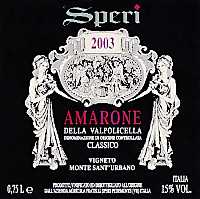
|
|
Amarone della Valpolicella Classico Vigneto Sant'Urbano 2003 |
|
| Speri (Veneto, Italy) | |
| Grapes: Corvina (70%), Rondinella (25%), Corvinone (5%) | |
| Price: € 45.00 | Score: |
| Amarone della Valpolicella Classico Vigneto Sant'Urbano shows an intense ruby red color and nuances of garnet red, little transparency. The nose reveals intense, clean, pleasing, refined and elegant aromas which start with hints of blackberry, plum and black cherry followed by aromas of dried violet, blueberry, tobacco, vanilla, menthol, pink pepper, chocolate, mace and clover. The mouth has good correspondence to the nose, a tannic attack and pleasing roundness, however balanced by alcohol, full body, intense flavors, agreeable. The finish is persistent with flavors of blackberry, black cherry and plum. A well made wine. This Amarone ages for 30 months in cask. | |
| Food Match: Game, Roasted meat, Stewed and braised meat, Hard cheese | |
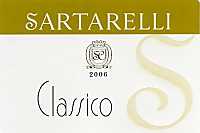
|
|
Verdicchio dei Castelli di Jesi Classico 2006 |
|
| Sartarelli (Marches, Italy) | |
| Grapes: Verdicchio | |
| Price: € 7.00 | Score: |
| This wine shows a brilliant greenish yellow color and nuances of greenish yellow, very transparent. The nose reveals intense, clean and pleasing aromas that start with hints of pear, apple and peach followed by aromas of almond, hawthorn, broom and pineapple. The mouth has good correspondence to the nose, a crisp attack and however balanced by alcohol, good body, intense flavors. The finish is persistent with flavors of pear, peach and almond. | |
| Food Match: Pasta and risotto with fish and crustaceans, Dairy products, Eggs, Fried fish | |
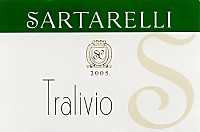
|
|
Verdicchio dei Castelli di Jesi Classico Superiore Tralivio 2005 |
|
| Sartarelli (Marches, Italy) | |
| Grapes: Verdicchio | |
| Price: € 12.00 | Score: |
| Tralivio shows a pale straw yellow color and nuances of greenish yellow, very transparent. The nose denotes intense, clean, pleasing and refined aromas which start with hints of apple, hawthorn and almond followed by aromas of pineapple, broom, pear, elder, plum and hints of mineral. The mouth has good correspondence to the nose, a crisp attack and however balanced by alcohol, good body, intense flavors, agreeable. The finish is persistent with flavors of apple, plum and almond. | |
| Food Match: Broiled fish, Roasted white meat, Fish soups | |
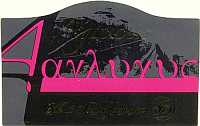
|
|
Aglucus 2003 |
|
| Colle di San Domenico (Campania, Italy) | |
| Grapes: Aglianico | |
| Price: € 25.00 | Score: |
| Aglucus shows an intense ruby red color and nuances of garnet red, little transparency. The nose denotes intense, clean, pleasing and refined aromas that start with hints of black cherry, plum and blackberry followed by aromas of blueberry, violet, vanilla, tobacco, pink pepper, carob and cinnamon. The mouth has good correspondence to the nose, a tannic attack and however balanced by alcohol, good body, intense flavors, agreeable. The finish is persistent with flavors of plum, black cherry and blackberry. Aglucus ages for 12 months in cask followed by at least 6 months of aging in bottle. | |
| Food Match: Roasted meat, Braised and stewed meat with mushrooms, Hard cheese | |
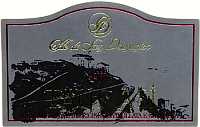
|
|
Taurasi Riserva 1999 |
|
| Colle di San Domenico (Campania, Italy) | |
| Grapes: Aglianico | |
| Price: € 20.50 | Score: |
| This Taurasi Riserva shows a brilliant ruby red color and nuances of garnet red, moderate transparency. The nose reveals intense, clean, pleasing and refined aromas which start with hints of black cherry, plum and violet followed by aromas of blackberry, blueberry, vanilla, tobacco, licorice, carob and menthol. The mouth has good correspondence to the nose, a tannic attack and however balanced by alcohol, good body, intense flavors. The finish is persistent with flavors of black cherry, plum and blackberry. This Taurasi Riserva ages for 3 years in cask followed by 12 months of aging in bottle. | |
| Food Match: Game, Roasted meat, Braised and stewed meat, Hard cheese | |
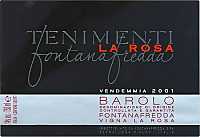
|
|
Barolo Fontanafredda Vigna La Rosa 2001 |
|
| Fontanafredda (Piedmont, Italy) | |
| Grapes: Nebbiolo | |
| Price: € 40.70 | Score: |
| Barolo Fontanafredda Vigna La Rosa shows a brilliant ruby red color and nuances of brick red, moderate transparency. The nose reveals intense, clean, pleasing and refined aromas that start with hints of cherry, plum and rose followed by aromas of violet, strawberry, raspberry, vanilla, tobacco, chocolate, cinnamon and menthol. The mouth has good correspondence to the nose, a tannic attack and pleasing crispness, however balanced by alcohol, full body, intense flavors. The finish is persistent with flavors of cherry, plum and raspberry. Barolo Fontanafredda Vigna La Rosa ages for 12 months in barrique followed by 12 months of aging in cask and 12 months of aging in bottle. | |
| Food Match: Game, Roasted meat, Braised and stewed meat, Hard cheese | |
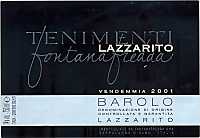
|
|
Barolo Lazzarito Vigna La Delizia 2001 |
|
| Fontanafredda (Piedmont, Italy) | |
| Grapes: Nebbiolo | |
| Price: € 44.00 | Score: |
| Barolo Lazzarito Vigna La Delizia shows a brilliant ruby red color and nuances of brick red, moderate transparency. The nose reveals intense, clean, pleasing, refined and elegant aromas which start with hints of cherry, violet and plum followed by aromas of raspberry, rose, tobacco, vanilla, mace, chocolate, licorice, cinnamon, white pepper and menthol. The mouth has excellent correspondence to the nose, a tannic attack and pleasing crispness, however balanced by alcohol, full body, intense flavors, agreeable roundness. The finish is very persistent with long flavors of cherry, plum and raspberry. A well made wine. Barolo Lazzarito Vigna La Delizia ages for 12 months in barrique followed by 12 months of aging in cask and 12 months of aging in bottle. | |
| Food Match: Game, Roasted meat, Braised and stewed meat, Hard cheese | |
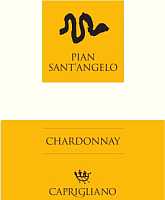
|
|
Pian Santangelo 2006 |
|
| Caprigliano (Latium, Italy) | |
| Grapes: Chardonnay | |
| Price: € 6.50 | Score: |
| The wine shows a pale straw yellow color and nuances of greenish yellow, very transparent. The nose denotes intense, clean and pleasing aromas which start with hints of banana, pear and pineapple followed by aromas of acacia, apple and broom. The mouth has good correspondence to the nose, a crisp attack and however balanced by alcohol, good body, intense flavors. The finish is persistent with flavors of banana, apple and pineapple. This wine ages in steel tanks. | |
| Food Match: Fried fish, Pasta and risotto with fish, Sauteed white meat | |
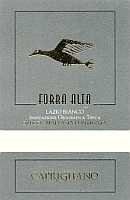
|
|
Forra Alta 2006 |
|
| Caprigliano (Latium, Italy) | |
| Grapes: Greco Bianco (50%), Malvasia del Lazio (50%) | |
| Price: € 6.00 | Score: |
| Forra Alta shows an intense golden yellow color and nuances of straw yellow, very transparent. The nose reveals intense, clean, pleasing and refined aromas that start with hints of peach, apple and pear followed by aromas of hawthorn, citrus fruits, plum and anise. The mouth has good correspondence to the nose, a crisp attack and pleasing roundness, however balanced by alcohol, good body, intense flavors. The finish is persistent with flavors of apple, plum and peach. | |
| Food Match: Mushrooms soups, Stuffed pasta with meat, Roasted white meat, Roasted fish | |
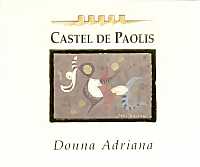
|
|
Donna Adriana 2006 |
|
| Castel De Paolis (Latium, Italy) | |
| Grapes: Malvasia Puntinata, Viognier, Sauvignon Blanc | |
| Price: € 16.00 | Score: |
| Donna Adriana shows a brilliant greenish yellow color and nuances of greenish yellow, very transparent. The nose reveals intense, clean, pleasing and refined aromas that start with hints of peach, pear and nettle followed by aromas of pineapple, banana, litchi, gooseberry, apple and broom. The mouth has good correspondence to the nose, a crisp attack and however balanced by alcohol, good body, intense flavors, agreeable. The finish is persistent with flavors of peach, pear and pineapple. Donna Adriana ages in steel tanks. | |
| Food Match: Pasta with mushrooms and fish, Fried fish, Stewed fish, Sauteed white meat | |
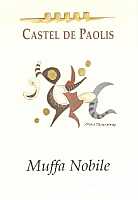
|
|
Muffa Nobile 2006 |
|
| Castel De Paolis (Latium, Italy) | |
| Grapes: Sémillon (80%), Sauvignon Blanc (20%) | |
| Price: € 20.00 - 500ml | Score: |
| Muffa Nobile shows a brilliant amber yellow color and nuances of amber yellow, transparent. The nose reveals intense, clean, pleasing and refined aromas that start with hints of dried apricot, date and raisin followed by aromas of peach jam, quince jam, candied fruits, dried fig, almond, honey, vanilla and musk. The mouth has good correspondence to the nose, a sweet and round attack, however balanced by alcohol, good body, intense flavors, pleasing crispness. The finish is persistent with flavors of raisin, dried apricot and honey.Muffa Nobile is produced with grapes completely affected by Botrytis Cinerea. | |
| Food Match: Hard and piquant cheese, Desserts | |
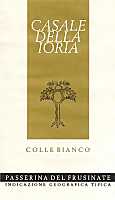
|
|
Colle Bianco 2006 |
|
| Casale della Ioria (Latium, Italy) | |
| Grapes: Passerina | |
| Price: € 5.00 | Score: |
| Colle Bianco shows a brilliant straw yellow color and nuances of straw yellow, very transparent. The nose reveals intense, clean and pleasing aromas that start with hints of apple, hawthorn and almond followed by aromas of broom and plum. The mouth has good correspondence to the nose, a crisp attack and pleasing roundness, however balanced by alcohol, good body, intense flavors. The finish is persistent with flavors of apple, plum and almond. The finish is pretty persistent with flavors of apple, plum and almond. Colle Bianco ages for 4 months in steel tanks. | |
| Food Match: Fish and vegetables appetizers, Risotto with fish, Boiled fish | |

|
|
Frascati Superiore Linea Storica 2006 |
|
| Casale Mattia (Latium, Italy) | |
| Grapes: Malvasia di Candia, Malvasia Bianca, Trebbiano Giallo, Bombino, Bellone | |
| Price: € 10.00 | Score: |
| Frascati Superiore Linea Storica shows a pale straw yellow color and nuances of greenish yellow, very transparent. The nose denotes intense, clean, pleasing and refined aromas that start with hints of gooseberry, apple and pear followed by aromas of hawthorn, broom, plum and hazelnut. The mouth has good correspondence to the nose, a crisp attack and however balanced by alcohol, good body, intense flavors, pleasing roundness. The finish is persistent with flavors of apple, gooseberry and plum. Frascati Superiore Linea Storica ages in steel tanks. | |
| Food Match: Fried fish, Pasta with fish, Roasted fish, Roasted white meat | |
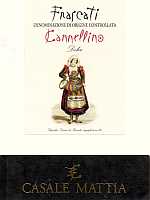
|
|
Frascati Cannellino 2006 |
|
| Casale Mattia (Latium, Italy) | |
| Grapes: Malvasia di Candia, Malvasia Bianca, Trebbiano Giallo, Bombino | |
| Price: € 7.00 - 500ml | Score: |
| Frascati Cannellino shows a brilliant straw yellow color and nuances of greenish yellow, very transparent. The nose denotes intense, clean, pleasing and refined aromas that start with hints of apple, hawthorn and almond followed by aromas of candied fruits, honey, pear and plum. The mouth has good correspondence to the nose, a sweet and crisp attack, however balanced by alcohol, good body, intense flavors, agreeable roundness. The finish is persistent with flavors of apple, plum and honey. | |
| Food Match: Fruit desserts | |
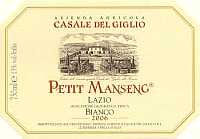
|
|
Petit Manseng 2006 |
|
| Casale del Giglio (Latium, Italy) | |
| Grapes: Petit Manseng | |
| Price: € 8.40 | Score: |
| This Petit Manseng shows an intense greenish yellow color and nuances of greenish yellow, very transparent. The nose denotes intense, clean, pleasing and refined aromas that start with hints of apple, pineapple and nettle followed by aromas of peach, pear, mango, grapefruit, broom and elder. The mouth has good correspond to the nose, a crisp attack and however balanced by alcohol, good body, intense flavors, agreeable. The finish is persistent with flavors of pineapple, apple and peach. | |
| Food Match: Pasta and risotto with crustaceans and mushrooms, Stewed fish, Broiled crustaceans | |
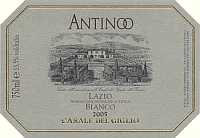
|
|
Antinoo 2005 |
|
| Casale del Giglio (Latium, Italy) | |
| Grapes: Chardonnay (66%), Viognier (34%) | |
| Price: € 9.90 | Score: |
| Antinoo shows a brilliant straw yellow color and nuances of straw yellow, very transparent. The nose reveals intense, clean, pleasing and refined aromas that start with hints of banana, apple and plum followed by aromas of hazelnut, vanilla, mineral, hawthorn, pear and grapefruit. The mouth has good correspondence to the nose, a crisp attack and however balanced by alcohol, good body, intense flavors, agreeable roundness. The finish is persistent with flavors of banana, apple and plum. Antinoo ages in barrique for 8 months followed by 12 months of aging in bottle. | |
| Food Match: Stuffed pasta with mushrooms, Roasted fish, Roasted white meat | |
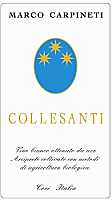
|
|
Collesanti 2006 |
|
| Marco Carpineti (Latium, Italy) | |
| Grapes: Arciprete Bianco Bellone | |
| Price: € 6.20 | Score: |
| Collesanti shows a pale straw yellow color and nuances of greenish yellow, very transparent. The nose denotes intense, clean and pleasing aromas which start with hints of peach, pineapple and apple followed by aromas of hazelnut, hawthorn, pear and broom. The mouth has good correspondence to the nose, a crisp attack and however balanced by alcohol, good body, intense flavors. The finish is persistent with flavors of pineapple, peach and apple. Collesanti ages in steel tanks. | |
| Food Match: Sauteed fish, Pasta and risotto with fish and crustaceans, Sauteed white meat | |
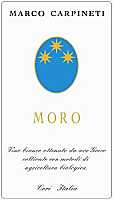
|
|
Moro 2006 |
|
| Marco Carpineti (Latium, Italy) | |
| Grapes: Greco Bianco | |
| Price: € 8.00 | Score: |
| Moro shows a pale straw yellow color and nuances of greenish yellow, very transparent. The nose reveals intense, clean, pleasing and refined aromas that start with hints of apple, plum and peach followed by aromas of hawthorn, pineapple, pear, broom and almond. The mouth has good correspondence to the nose, a crisp attack and however balanced by alcohol, good body, intense flavors. The finish is persistent with flavors of apple, plum and peach. Moro ages in steel tanks. | |
| Food Match: Fried fish, Pasta and risotto with fish and crustaceans, Sauteed fish | |
|
||||||||
|
DiWineTaste Polls
|
| |||||||
Privacy Policy | |||||||


| Copyright © 2002-2024 Antonello Biancalana, DiWineTaste - All rights reserved |
| All rights reserved under international copyright conventions. No part of this publication and of this WEB site may be
reproduced or utilized in any form or by any means, electronic or mechanical, without permission in writing from DiWineTaste. |